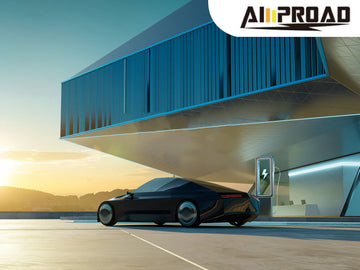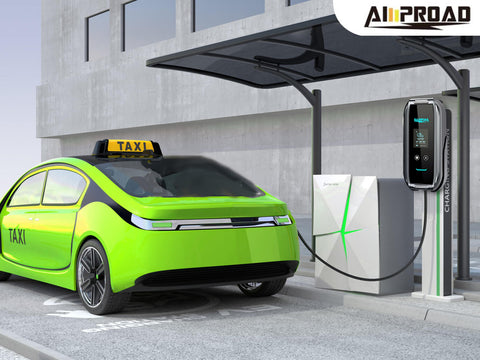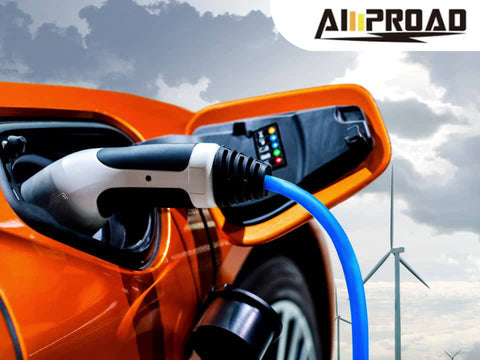
As electric vehicles (EVs) gain traction, understanding the competitiveness of their charging costs versus traditional fueling options becomes paramount. Several factors contribute to this comparison.
Cost of Electricity vs. Cost of Gasoline
When comparing the cost of electricity for EV charging to the cost of gasoline for traditional vehicles, several factors come into play. Generally, the cost of electricity tends to be lower per mile traveled compared to gasoline. The exact comparison varies based on factors such as local electricity rates and gasoline prices. On average, charging an EV at home can be significantly cheaper than filling up a gasoline-powered vehicle at the pump. Additionally, many EV owners benefit from lower electricity rates, especially if they charge during off-peak hours or take advantage of special EV charging programs offered by utilities. However, it's essential to consider that the cost of electricity for EV charging may vary depending on the charging method used, such as Level 1, Level 2 charging, or DC fastest charging, as well as any associated fees at public charging stations. Overall, while electricity costs for EV charging generally offer savings compared to gasoline, the exact comparison depends on various factors and charging practices.
Efficiency of Electric Vehicles vs. Internal Combustion Engine Vehicles
In terms of energy consumption, electric vehicles (EVs) are generally more efficient than internal combustion engine (ICE) vehicles. The efficiency of an EV comes from its ability to convert a higher percentage of the energy stored in its battery into usable power for propulsion, whereas ICE vehicles lose a significant portion of their energy through heat and other inefficiencies. One key factor contributing to this efficiency is the regenerative braking system in EVs, which captures energy during braking and converts it back into electricity to recharge the battery. Additionally, EVs have fewer moving parts compared to ICE vehicles, resulting in less energy loss due to friction and mechanical inefficiencies.
When it comes to charging efficiency, EVSE Level 2 chargers offer faster and more efficient charging compared to standard Level 1 chargers. Level 2 chargers utilize higher voltage and current levels, allowing EVs to charge at a quicker rate. This efficiency not only reduces charging time but also maximizes the use of electricity, ensuring that more energy is transferred to the EV's battery during the charging process. Overall, the efficiency of electric vehicles, combined with advancements in charging infrastructure like Level 2 EV chargers, positions EVs as a more energy-efficient and sustainable transportation option compared to internal combustion engine vehicles.
Variability of Electricity Prices vs. Stability of Gasoline Prices
Fluctuations in electricity prices can affect the competitiveness of EV charging costs compared to the stability of gasoline prices. When electricity prices are low, EV charging becomes more affordable, offering potential savings for EV owners compared to gasoline-powered vehicles. However, if electricity prices rise significantly, the cost advantage of EV charging may diminish, impacting the overall cost competitiveness. On the other hand, gasoline prices tend to be more stable and less prone to drastic fluctuations compared to electricity prices. This stability provides a degree of predictability for traditional vehicle owners, who can anticipate fuel costs more reliably over time. Despite this, the long-term trend often favors EV owners, as electricity prices are generally more stable and less susceptible to external factors such as geopolitical events or fluctuations in global oil markets. Overall, while fluctuations in electricity prices can influence the competitiveness of EV charging costs, the stability of gasoline prices offers a level of consistency that traditional vehicle owners may find reassuring.
Charging Infrastructure Costs vs. Gas Station Infrastructure Costs
The costs associated with building and maintaining EV charging infrastructure differ from those of traditional gas station infrastructure. Building EV charging infrastructure, such as Level 2 EV charger and Tesla destination charger, typically involves lower initial construction costs compared to gas stations. EV charging stations require fewer components, such as underground fuel tanks and complex dispensing systems, reducing installation expenses. Moreover, the absence of flammable liquids in EV charging infrastructure eliminates the need for costly safety measures like fire suppression systems, further reducing construction costs.
Maintenance costs for EV charging infrastructure are also generally lower compared to traditional gas stations. EV charging stations have fewer moving parts and require less frequent maintenance, resulting in reduced upkeep expenses. Additionally, advancements in technology have led to more reliable EV charging equipment, minimizing the need for repairs and replacements.
However, one challenge associated with EV charging infrastructure is the need for upgrades to electrical systems to support Level 2 EV chargers and other high-power charging stations. While this can add to the initial cost, it is often offset by the long-term savings associated with lower maintenance and operational costs.
In contrast, traditional gas stations require regular maintenance of underground fuel storage tanks, fuel pumps, and other equipment, which can be costly. Furthermore, environmental regulations often require gas stations to implement expensive safety measures to prevent fuel leaks and contamination of soil and groundwater.
Overall, while there are upfront costs associated with building and upgrading electrical systems for EV charging infrastructure, the long-term operational and maintenance savings make it a more cost-effective option compared to traditional gas station infrastructure.
Incentives and Subsidies for EV Adoption
Government incentives and subsidies for EV adoption play a crucial role in enhancing the overall cost competitiveness of EV charging. These incentives can take various forms, such as tax credits, rebates, grants, and subsidies, aimed at reducing the upfront costs of purchasing EVs and installing EV charging infrastructure. By offsetting a portion of the initial investment, incentives make EVs and EV charging equipment more affordable for consumers and businesses alike.
Moreover, government incentives often target specific aspects of EV adoption, such as the installation of residential or commercial EV charging stations. For example, some incentives may cover a percentage of the installation costs for Level 2 EV charger or provide funding for the deployment of public charging infrastructure in underserved areas. By incentivizing the deployment of EV charging infrastructure, governments help expand access to charging facilities, making EV ownership more convenient and attractive for consumers.
Overall, government incentives and subsidies for EV adoption contribute to the competitiveness of EV charging by lowering barriers to entry, reducing costs, and accelerating the transition to electric transportation.
Long-Term Cost Savings for EV Owners

EV owners enjoy significant long-term cost savings compared to traditional vehicle owners, primarily due to lower maintenance and fueling expenses. One major contributor to these savings is the reduced maintenance requirements of electric vehicles. EVs have fewer moving parts than internal combustion engine vehicles, resulting in lower wear and tear and reduced maintenance costs over time. Additionally, EVs do not require oil changes, transmission fluid replacements, or exhaust system repairs, further reducing maintenance expenses.
Another factor driving long-term cost savings for EV owners is the lower cost of fueling. Charging an EV at home with a home EV charger is typically much cheaper than refueling a traditional vehicle with gasoline. This is particularly true when electricity rates are low or when EV owners take advantage of off-peak charging rates offered by utilities. Additionally, EV owners may benefit from government incentives and rebates for EV charging equipment installation, further reducing the overall cost of ownership.
When considering these factors together, it becomes evident that the long-term cost savings for EV owners can be substantial compared to traditional vehicle owners. By minimizing maintenance expenses and offering cheaper fueling options through home EV chargers, EVs provide a cost-effective and sustainable transportation solution for consumers.
Environmental and Social Costs of Traditional Fueling
Traditional fueling options come with significant environmental and social costs that factor into the overall cost comparison. Environmentally, the combustion of fossil fuels emits greenhouse gases, contributing to climate change and air pollution. This pollution has detrimental effects on public health, leading to respiratory problems and other health issues, which in turn incur healthcare costs and productivity losses. Additionally, the extraction, transportation, and refining of fossil fuels can cause habitat destruction, water pollution, and ecosystem degradation, further exacerbating environmental impacts.
Socially, traditional fueling options are often associated with geopolitical tensions and conflicts over access to oil reserves. These conflicts can result in military interventions, displacement of communities, and human rights abuses, leading to social unrest and instability. Moreover, reliance on fossil fuels perpetuates economic disparities, as wealth generated from oil extraction is often concentrated in the hands of a few, while communities reliant on fossil fuel industries may suffer from economic downturns and job losses.
When considering the environmental and social costs associated with traditional fueling options, it becomes clear that these factors significantly impact the overall cost comparison. While the immediate financial costs of traditional fueling may appear lower, the hidden costs associated with environmental degradation, public health, and social consequences must be taken into account to accurately assess the true cost of traditional fueling options.
Future Outlook for EV Charging Costs
Advancements in technology and changes in energy policies are expected to have a significant impact on the competitiveness of EV charging costs in the future. Technological advancements in battery technology, charging infrastructure, and electric vehicle efficiency are likely to drive down the cost of EV charging. Improved battery technology will lead to longer battery life and faster charging times, making EVs more convenient and affordable for consumers. Additionally, innovations in charging infrastructure, such as the development of ultra-fast charging stations and wireless charging technology, will further reduce charging times and enhance the accessibility of EV charging.
Changes in energy policies, including incentives for renewable energy sources and carbon pricing mechanisms, will also play a crucial role in shaping the future of EV charging costs. Increased investment in renewable energy sources, such as solar and wind power, will lower the cost of electricity generation, making EV charging more economical and environmentally friendly. Furthermore, carbon pricing policies, such as carbon taxes or cap-and-trade systems, will incentivize the adoption of low-carbon transportation solutions like electric vehicles, further driving down the cost of EV charging.
Overall, advancements in technology and changes in energy policies are expected to accelerate the transition to electric transportation and make EV charging more competitive with traditional fueling options in the future. As EVs become more affordable and convenient to own and operate, they will increasingly become the preferred choice for consumers seeking sustainable and cost-effective transportation solutions, especially with the availability of the fastest home EV charger.



